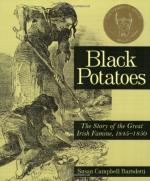|
This section contains 1,158 words (approx. 3 pages at 400 words per page) |

|
Survival, courage, and hope are this history's dominant themes. The main characters are the six million Irish farm laborers who confronted their situation by acting pro-actively and defiantly, refusing to be passive victims of their circumstances. The recurring potato blight is presented as a villainous character that viciously assaults potatoes which are essential to the livelihood and nutritional well-being of the Irish people.
Prejudice and exclusion are also relevant themes. Nineteenth-century Irish society was divided into three basic social classes. The landlords were mostly Protestant British property owners who were often absent from their lands. Farmers rented varying sizes of acreage depending on their financial resources. The laborers worked land to earn wages and secure food. These agricultural workers were isolated from the landowners because of language, literacy, and cultural, economic, and religious differences.
The disruption of consistently practiced routines resulted in chaos. The Irish observed...
|
This section contains 1,158 words (approx. 3 pages at 400 words per page) |

|




